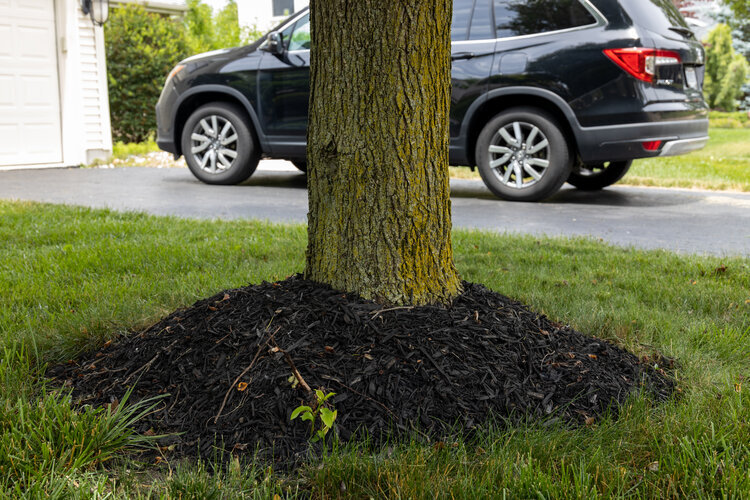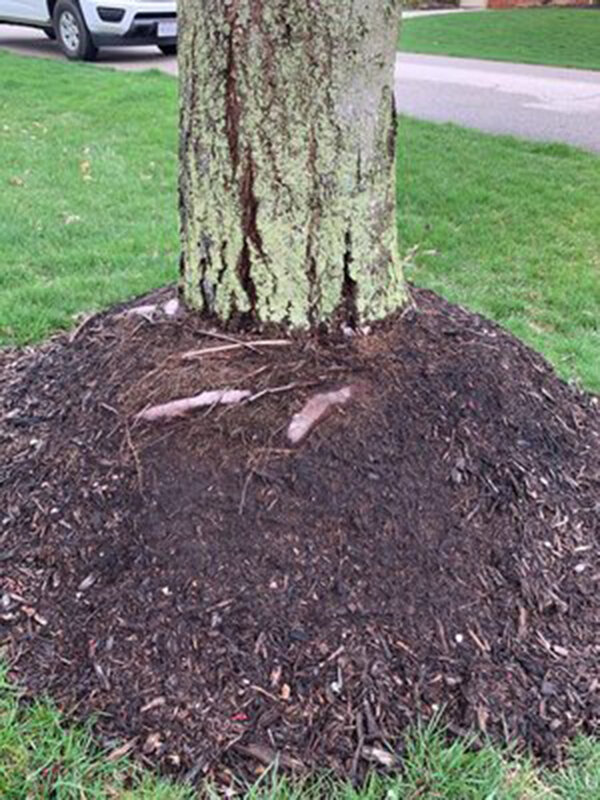There are times when the professionals at Russell Tree Experts should be utilized, although I realize there may be situations when removing a single branch is something very achievable by you, the homeowner.
What's Wrong with my Sycamore & Maple?
"Why does my beautiful maple have ugly black spots on its leaves?" "Why is my American sycamore bare this year” …To answer these questions, we need to go back to a chilly, wet evening 5 weeks ago. On May 5th, the temperature dropped overnight to 41 degrees just after an early morning shower that day. We continued this cool, wet trend for 10 lousy days, and…
Brood X Cicada: Facts & Tips
Why Can’t I Plant a Tree Just Anywhere?
When I first began working at Russell Tree Experts as a video production assistant, I had no significant prior knowledge of arboriculture, and I never really understood the concept of tree planting. My overall impression was that trees are good for the environment as they provide oxygen, contribute to an ecosystem, and are visually pleasing to look at and enjoy.
Recap: Arbor Day 2021
Free Trees to Celebrate Arbor Day!
17
Seventeen years ago near this season I was starting my second year as an arborist in training. A few months more into the year and I would be applying to the ISA to sit for the Certified Arborist examination, which thankfully I would pass. At this point in my career, I was fortunate to be working under a foreman who was (and is) passionate about trees, so as I learned primarily about climbing and pruning, I was also being taught about CODIT, tree identification, and common tree pests and diseases.
How to Mulch Around a Tree
Dear Readers,
Mulching is an important aspect of tree maintenance that is both functional and decorative, adding to your tree’s lifespan and helping it look its best. The main benefits of tree mulching are that it deters weeds, improves soil quality, protects trees from lawnmower damage, insulates soil from extreme temperatures, and retains moisture during hot weather. Today, I would like to talk about some tips and tricks on how to properly mulch a tree. At the top of this article is an instructional video hosted by ISA Certified Arborist Lindsey Rice that can be used to follow along while mulching your own tree!
Example of a properly mulched tree
To mulch a tree, you will need organic wood chip mulch, a shovel, a rake, and personal protective equipment such as safety glasses, gloves, and boots. A wheelbarrow or air spade may potentially be needed depending on the situation. The best time to mulch a tree is in the fall or spring. Many trees are incorrectly mulched when the mulch is too high or when it covers the root collar of the tree, which is where the trunk and roots meet. The mulch only needs to be 1 to 2 inches deep and the root collar should be completely exposed in order to properly receive oxygen. This will help prevent girdling roots, which are roots that wrap around the trunk in search of oxygen. This can suffocate a tree and add unnecessary stress. If your tree has girdling roots or a mulch volcano, you will need to resolve these issues prior to mulching.
If there are no girdling roots, the first step is to pull out any weeds surrounding the base of the tree. Then, you may begin applying mulch in a wide and evenly spread area. For younger trees, it is ideal to mulch all the way out to the canopy drip line, which is where the majority of a tree’s roots extend, but you may have to compromise depending on your landscape.
Example of a canopy drip line
For older trees, this is not as important. You should still see similar results when bringing the mulch out about 3 to 5 feet from the base. You can use a rake, shovel, or your hands to evenly distribute the mulch. The mulch only has to be about 1 to 2 inches deep at most, so make sure you avoid mounding, Leave about 2 to 3 inches of space between the mulch and the root collar in order for the tree to properly receive oxygen and to prevent girdling roots. This will also help prevent any moisture issues, which can lead to disease and rotting. Afterwards, you are all set!
For maintenance, water your mulch whenever it looks dry. Ohio can have inconsistent weather, so there is no need to water it on a scheduled basis. Also, only add mulch whenever it is looking sparse and below that 1 to 2 inch needed depth. Make sure you break up, turn over, and mix in the old mulch to prolong the mulch’s lifespan, prevent any clumping, and to allow maximum movement of oxygen and water. If there are any questions, please feel free to leave them in the comments section below and be sure to watch ISA Certified Arborist Lindsey Rice’s video for a visual guide on this topic! Good luck on your next mulching project!
Additional Reads!
Below are two excellent articles written by our ISA Certified Arborists related to mulch volcanoes and girdling roots.
”Mulch Mounds! Oh My!”
by ISA Board Certified Master Arborist José Fernández
“Are Your Trees Being Suffocated By Their Own Roots?”
by ISA Certified Arborist Chris Gill
Enrique Arayata I Video Production Assistant, Russell Tree Experts
Enrique is a third year student at The Ohio State University majoring in moving image production with a double minor in photography and film studies. In his free time, he enjoys running, spending time with his girlfriend and family, photography, and creating YouTube videos.
How to Verify a Certified Arborist Credential
Recently, it was brought to my attention that there are some people performing tree work in the area claiming to be “certified arborists” when in fact, they are not. So… how can you tell if someone is telling the truth? One way is to ask for a business card or ask for their ISA Certified Arborist® credential number which will be in the following format: [state abbreviation] – [four digits] [letter]. Here is an example of a business card (mine!) with the credential number explicitly listed:
The best way to verify this credential number is to search on the ISA Certified Arborist® database. Simply go to treesaregood.org, click the “Find an Arborist” section then choose “Verify a Credential.” From there, enter the credential certification number and submit the request to see if the credential is in fact genuine.
Over my time working at Russell Tree Experts, I’ve sadly heard countless stories of “door knockers” coming by a person’s home and ruining their beloved tree. It’s a very sad occurrence in our industry and we hope through education these stories can lessen.
Improper tree work not only can cause irreparable damage to the tree or property, but there is also potential for spreading disease to nearby trees and affecting others’ landscapes. Tree care can also be very dangerous work, for both the property owner and the person doing the work. We highly recommend hiring an ISA Certified professional (even if it’s not us!) with the proper equipment, knowledge, and experience to perform your challenging tree work. The health of our environment relies on proper care for our trees so we may enjoy their countless benefits from improving air quality to providing homes for wildlife and beyond!
We’re very proud to have 19 ISA Certified Arborists® on our staff! Feel free to double-check their credentials at treesaregood.org! :)
Lindsey Rice | Office Manager, Russell Tree Experts
Lindsey joined Russell Tree Experts in 2015 with a B.S. in Agribusiness and a minor in Horticulture from The Ohio State University. Growing up in Northwest Ohio, she participated in various sports, band, and FFA which ultimately inspired her love for the tree industry. She loves to spend her free time outdoors with her husband and daughters.
Is my boxwood trying to tell me something?
Pruning Upper Arlington's Oldest Tree
New Disease Control Measures for Oak & Elm Trees
… I hope everyone is having a great week and enjoying this sunshiny weather! I love being able to get outside with my girls and get some vitamin D and open our windows and get some fresh air. With spring around the corner, I wanted to bring to your attention that Russell Tree Experts is implementing some new Oak tree and Elm tree safety procedures to ensure the health and safety of these types of trees in the Columbus area.
Here... There... (and what feels like) Everywhere
Lecanium Scale (Part Two)
Lecanium Scale (Part One)
If “Lecanium” is a new word for you, consider yourself lucky, or at worst, blissfully ignorant. If you have experienced species of this genus in your landscape you may know how devastating, unsightly, and generally… uncomfortable this insect can be. If you have ever stood under a tree covered in a scale population which is actively feeding and digesting you will know why the word “uncomfortable” came to mind. In this installment I will briefly describe Lecanium scale and its life cycle. In the next installment, I will share an unusual finding from last season, and stand out on a limb to make a forecast for this season.
♥ Happy Valentine's Day! ♥
Don’t you miss handing out Valentine’s Day cards at school? Did you make the shoe box and hope to get a card from that special someone? We’re feeling a little nostalgic this year so we decided to create some tree-inspired mini Valentine’s Day cards. You may not be in grade school anymore but take a moment and feel like a kid again by printing our Valentine’s Day cards below and give ‘em to your special someone!
Where’s the Fruit?
As an arborist, I often feel like I need to double as a detective. Trees, obviously, cannot tell us verbally how they are "feeling" or why they are behaving in a certain way. We have to look for clues as to what is possibly going on with them. When I am asked why a tree is performing poorly, oftentimes I need to swap out my helmet for a Sherlock Holmes cap and start digging around, asking questions of the tree's caretaker and standing back to observe the environment in which the tree exists.
Planting Trees for a Purpose
I think we all can agree that our TREE FOR A TREE® program is an awesome idea for replacing the trees that we remove, but as I set in the office watching nature happen outside my window, I started thinking of other reasons to plant trees. Trees provide countless benefits to our environment as well as providing food and shelter for a number of living organisms. Anytime that I am walking through a property I cannot help but notice the birds enjoying all that the trees are providing for them. I decided to write about planting trees that provide shelter and food for birds throughout the year.
Understanding Conifers
Understanding conifers should begin with a few simple definitions to clarify and classify. A conifer is a plant that bears its seeds in cones. When we hear the word cone, we likely think of pine and spruce trees, two types of coniferous trees that are widely found throughout Central Ohio and beyond. Their cones are obvious when they fall and scatter on the ground surrounding the tree. But did you know that yews (Taxus) and junipers are also conifers?
Putting the Year to Sleep
Today the light begins to increase again; days begin to lengthen. For the last 6 months or so each day has lost a minute or two of daylight, growing shorter as this part of the world approached the darkest day of the year. Earlier this week I was reading the musings of Henry David Thoreau once again, and came across a passage about the wonders of a milkweed seed, how each seed is carefully packed within its “light chest” attached to silk streamers, to be released when the time is right. Thoreau ends the thought with a quiet reflection on the faith of a milkweed plant which “matures its seeds” despite the prophecies of some men that the world would end.










